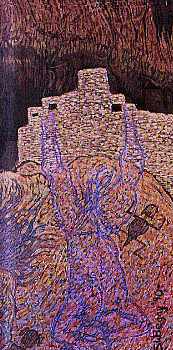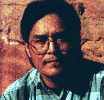ANASAZI DIASPORA, |
 |
|---|
|
"Yes, My Grandson, those ancient ones were blessed in many ways. They were taught by the spirits ways to live productive and holy lives. They lived and enjoyed the blessings. They built great cities, they made beautiful pottery, they had fields of golden corn. They needed nothing beyond that. But they became lazy. This offended the spirits." "How?" "They chose to live easy lives instead of living by the rules they were taught to maintain holiness." "What were those rules?" "They were to recognize the gods. To pay them homage. To observe ceremonies. To celebrate seasons. To celebrate births and other stages of life. Special healers were appointed and given power to remove illness and restore harmony. But the healers decided to perform this ceremony for everyone, regardless of their health and age. Four times they were warned not to abuse the ceremony. Four times, they chose not to listen." "And . . . ?" "On the fifth day, the great wind rose out of the canyon walls and roared throughout the land. People were lifted out of their homes, out of their villages, out of the canyons and valleys. They were scattered throughout this land never to come together again. The buildings were left standing to remind us for all time what will happen if we choose to forget our history, our stories, and above all, our relation to our mother, the earth."
In his introduction to Navajo Visions and Voices Across the Mesa, he wrote: "The paintings and poems in this book explore facets of Navajo life that are rarely touched upon in Western literature. They will take you into the corners of my world, so that you may experience daily life on the mesa in the 20th century. You will also feel echoes and reverberations of the way things were here on the mesa many hundreds of years before Columbus." I am really sorry that my poor little scanner, and the poor resolution of web cannot capture the small, swirly brush strokes and fine details of his paintings, which are reproduced large in these books, supposedly for kids, but really for anyone who loves beauty. Begay also writes beautifully, poetically and clearly. Buy all his books for your school library, or why not get quite a lot of copies for reading circles? Instead of Dick and Jane get mugged on their way to the store. |
|---|
 The blue ghostly figure, flung head down from the cliff house at the top of the page, here, is one of the old Anasazi in Shonto Begay's story. This is part of a large painting running the double width of his oversize book's pages (and in actuality, it's a 24 x 36 inch arcylic on canvas painting). Begay's whole painting shows a small city built inside a cliff cave -- like
The blue ghostly figure, flung head down from the cliff house at the top of the page, here, is one of the old Anasazi in Shonto Begay's story. This is part of a large painting running the double width of his oversize book's pages (and in actuality, it's a 24 x 36 inch arcylic on canvas painting). Begay's whole painting shows a small city built inside a cliff cave -- like  Shonto Begay, a well-known Dineh artist has written and illustrated two other children's picture books, Ma'ii and Cousin Horned Toad (1993 Arizona Author award), and The Mud Pony, a Rainbow Reading selection. He was born in 1950 in a hogan, near Shonto, AZ, fifth of 16 children. Many of his paintings -- including some from his children's books -- are part of museum collections.
Shonto Begay, a well-known Dineh artist has written and illustrated two other children's picture books, Ma'ii and Cousin Horned Toad (1993 Arizona Author award), and The Mud Pony, a Rainbow Reading selection. He was born in 1950 in a hogan, near Shonto, AZ, fifth of 16 children. Many of his paintings -- including some from his children's books -- are part of museum collections. 